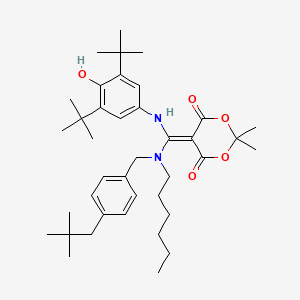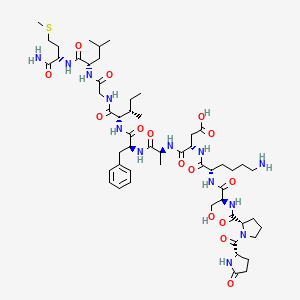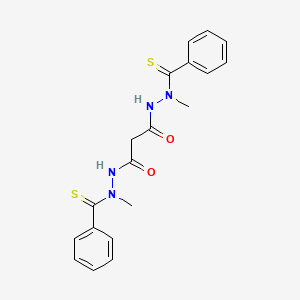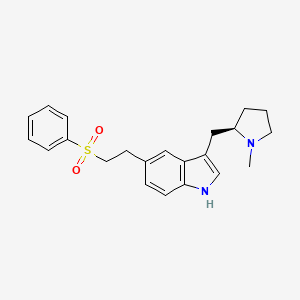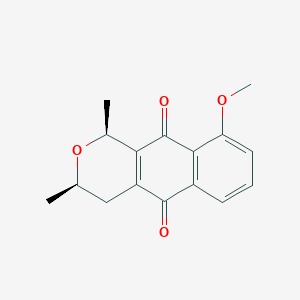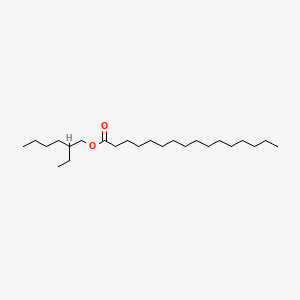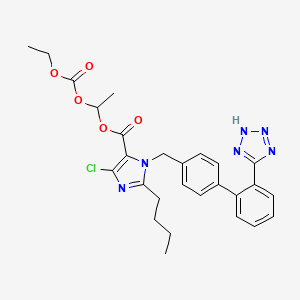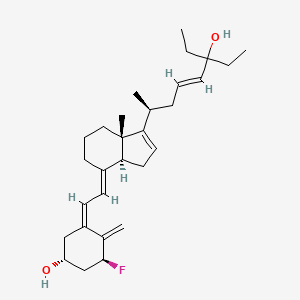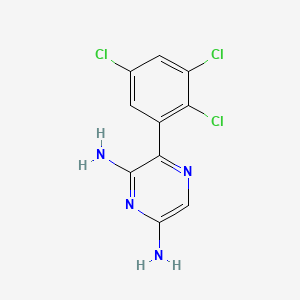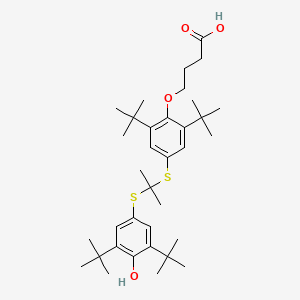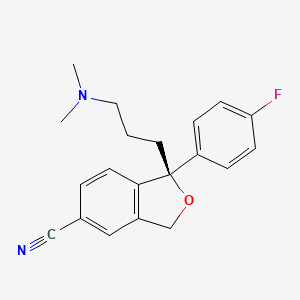
依他普仑
概述
描述
依他普仑是一种选择性血清素再摄取抑制剂,主要用作抗抑郁药。它是西酞普兰的S-对映体,这意味着它是该分子两种镜像形式之一。 依他普仑因其在抑制血清素转运体方面的选择性和效力而闻名,使其在治疗重度抑郁症和广泛性焦虑症方面非常有效 .
作用机制
依他普仑通过抑制血清素(一种神经递质)再摄取到突触前神经元而发挥作用。这种抑制增加了突触间隙中可用的血清素水平,从而增强了血清素能神经传递。 主要分子靶点是血清素转运体 (SERT),依他普仑结合到正构位点,阻止血清素再摄取 .
科学研究应用
生化分析
Biochemical Properties
The primary molecular target for Escitalopram is the serotonin transporter (SERT), which is responsible for serotonin (also called 5-hydroxytryptamine [5-HT]) reuptake at the terminals and cell bodies of serotonergic neurons . This leads to antidepressant effects by increasing extracellular 5-HT levels which enhance 5-HT neurotransmission .
Cellular Effects
Escitalopram exerts its effects by restoring serotonergic function in the treatment of depression and anxiety . It is approximately 150 times more potent than citalopram’s R-enantiomer and is responsible for the vast majority of citalopram’s clinical activity .
Molecular Mechanism
Escitalopram exerts its effects at the molecular level through binding interactions with the serotonin transporter (SERT). It has been shown that through allosteric binding, Escitalopram decreases its own dissociation rate from the orthosteric site on the SERT . This may be the mechanism responsible for its observed superior efficacy and faster onset compared to other SSRIs .
Metabolic Pathways
Escitalopram is involved in the serotonin reuptake metabolic pathway. It interacts with the serotonin transporter (SERT), affecting the reuptake of serotonin at the terminals and cell bodies of serotonergic neurons .
准备方法
合成路线和反应条件
依他普仑的合成涉及多个步骤,从前体西酞普兰开始。一种常见的方法包括使用手性色谱法将西酞普兰的外消旋混合物拆分为其对映体。 然后分离和纯化S-对映体 .
另一种方法包括二醇化合物的环化,然后是所得化合物的拆分。 二醇化合物通常以草酸盐的形式制备,以促进拆分过程 .
工业生产方法
依他普仑的工业生产通常遵循相同的合成路线,但规模更大。 在对映体的色谱分离中,通常使用手性固定相,如Chiralpak AD或Chiralcel OD 。该过程经过优化,以确保最终产品的产率和纯度高。
化学反应分析
反应类型
依他普仑会发生几种类型的化学反应,包括:
氧化: 依他普仑可以氧化成各种代谢产物。
还原: 还原反应不太常见,但可以在特定条件下发生。
常见试剂和条件
氧化: 常见的氧化剂包括高锰酸钾和过氧化氢。
还原: 可以使用像氢化铝锂这样的还原剂。
取代: 取代反应中使用氰化钠和钯催化剂等试剂.
主要产物
相似化合物的比较
类似化合物
西酞普兰: 依他普仑来源的外消旋混合物。
氟西汀: 另一种选择性血清素再摄取抑制剂,具有不同的化学结构。
独特性
依他普仑因其对血清素转运体的高度选择性和效力而独一无二。 一些临床研究表明,与它的外消旋混合物西酞普兰和其他选择性血清素再摄取抑制剂相比,它更有效,耐受性更好 。 它对血清素转运体的变构调节也有助于其优于其他选择性血清素再摄取抑制剂的疗效和更快的起效时间 .
属性
IUPAC Name |
(1S)-1-[3-(dimethylamino)propyl]-1-(4-fluorophenyl)-3H-2-benzofuran-5-carbonitrile | |
|---|---|---|
| Source | PubChem | |
| URL | https://pubchem.ncbi.nlm.nih.gov | |
| Description | Data deposited in or computed by PubChem | |
InChI |
InChI=1S/C20H21FN2O/c1-23(2)11-3-10-20(17-5-7-18(21)8-6-17)19-9-4-15(13-22)12-16(19)14-24-20/h4-9,12H,3,10-11,14H2,1-2H3/t20-/m0/s1 | |
| Source | PubChem | |
| URL | https://pubchem.ncbi.nlm.nih.gov | |
| Description | Data deposited in or computed by PubChem | |
InChI Key |
WSEQXVZVJXJVFP-FQEVSTJZSA-N | |
| Source | PubChem | |
| URL | https://pubchem.ncbi.nlm.nih.gov | |
| Description | Data deposited in or computed by PubChem | |
Canonical SMILES |
CN(C)CCCC1(C2=C(CO1)C=C(C=C2)C#N)C3=CC=C(C=C3)F | |
| Source | PubChem | |
| URL | https://pubchem.ncbi.nlm.nih.gov | |
| Description | Data deposited in or computed by PubChem | |
Isomeric SMILES |
CN(C)CCC[C@@]1(C2=C(CO1)C=C(C=C2)C#N)C3=CC=C(C=C3)F | |
| Source | PubChem | |
| URL | https://pubchem.ncbi.nlm.nih.gov | |
| Description | Data deposited in or computed by PubChem | |
Molecular Formula |
C20H21FN2O | |
| Source | PubChem | |
| URL | https://pubchem.ncbi.nlm.nih.gov | |
| Description | Data deposited in or computed by PubChem | |
DSSTOX Substance ID |
DTXSID8048440 | |
| Record name | Escitalopram | |
| Source | EPA DSSTox | |
| URL | https://comptox.epa.gov/dashboard/DTXSID8048440 | |
| Description | DSSTox provides a high quality public chemistry resource for supporting improved predictive toxicology. | |
Molecular Weight |
324.4 g/mol | |
| Source | PubChem | |
| URL | https://pubchem.ncbi.nlm.nih.gov | |
| Description | Data deposited in or computed by PubChem | |
Physical Description |
Solid | |
| Record name | Escitalopram | |
| Source | Human Metabolome Database (HMDB) | |
| URL | http://www.hmdb.ca/metabolites/HMDB0005028 | |
| Description | The Human Metabolome Database (HMDB) is a freely available electronic database containing detailed information about small molecule metabolites found in the human body. | |
| Explanation | HMDB is offered to the public as a freely available resource. Use and re-distribution of the data, in whole or in part, for commercial purposes requires explicit permission of the authors and explicit acknowledgment of the source material (HMDB) and the original publication (see the HMDB citing page). We ask that users who download significant portions of the database cite the HMDB paper in any resulting publications. | |
Solubility |
Sparingly soluble | |
| Record name | Escitalopram | |
| Source | DrugBank | |
| URL | https://www.drugbank.ca/drugs/DB01175 | |
| Description | The DrugBank database is a unique bioinformatics and cheminformatics resource that combines detailed drug (i.e. chemical, pharmacological and pharmaceutical) data with comprehensive drug target (i.e. sequence, structure, and pathway) information. | |
| Explanation | Creative Common's Attribution-NonCommercial 4.0 International License (http://creativecommons.org/licenses/by-nc/4.0/legalcode) | |
Mechanism of Action |
Escitalopram, like other selective serotonin re-uptake inhibitors, enhances serotonergic activity by binding to the orthosteric (i.e. primary) binding site on the serotonin transporter (SERT), the same site to which endogenous 5-HT binds, and thus prevents the re-uptake of serotonin into the presynaptic neuron. Escitalopram, along with [paroxetine], is also considered an allosteric serotonin re-uptake inhibitor - it binds to a secondary allosteric site on the SERT molecule to more strongly inhibit 5-HT re-uptake. Its combination of orthosteric and allosteric activity on SERT allows for greater extracellular 5-HT levels, a faster onset of action, and greater efficacy as compared to other SSRIs. The sustained elevation of synaptic 5-HT eventually causes desensitization of 5-HT1A auto-receptors, which normally shut down endogenous 5-HT release in the presence of excess 5-HT - this desensitization may be necessary for the full clinical effect of SSRIs and may be responsible for their typically prolonged onset of action. Escitalopram has shown little-to-no binding affinity at a number of other receptors, such as histamine and muscarinic receptors, and minor activity at these off-targets may explain some of its adverse effects., The mechanism of antidepressant action of escitalopram, the S-enantiomer of racemic citalopram, is presumed to be linked to potentiation of serotonergic activity in the central nervous system (CNS) resulting from its inhibition of CNS neuronal reuptake of serotonin (5-HT). | |
| Record name | Escitalopram | |
| Source | DrugBank | |
| URL | https://www.drugbank.ca/drugs/DB01175 | |
| Description | The DrugBank database is a unique bioinformatics and cheminformatics resource that combines detailed drug (i.e. chemical, pharmacological and pharmaceutical) data with comprehensive drug target (i.e. sequence, structure, and pathway) information. | |
| Explanation | Creative Common's Attribution-NonCommercial 4.0 International License (http://creativecommons.org/licenses/by-nc/4.0/legalcode) | |
| Record name | Escitalopram | |
| Source | Hazardous Substances Data Bank (HSDB) | |
| URL | https://pubchem.ncbi.nlm.nih.gov/source/hsdb/8410 | |
| Description | The Hazardous Substances Data Bank (HSDB) is a toxicology database that focuses on the toxicology of potentially hazardous chemicals. It provides information on human exposure, industrial hygiene, emergency handling procedures, environmental fate, regulatory requirements, nanomaterials, and related areas. The information in HSDB has been assessed by a Scientific Review Panel. | |
CAS No. |
128196-01-0 | |
| Record name | (+)-Citalopram | |
| Source | CAS Common Chemistry | |
| URL | https://commonchemistry.cas.org/detail?cas_rn=128196-01-0 | |
| Description | CAS Common Chemistry is an open community resource for accessing chemical information. Nearly 500,000 chemical substances from CAS REGISTRY cover areas of community interest, including common and frequently regulated chemicals, and those relevant to high school and undergraduate chemistry classes. This chemical information, curated by our expert scientists, is provided in alignment with our mission as a division of the American Chemical Society. | |
| Explanation | The data from CAS Common Chemistry is provided under a CC-BY-NC 4.0 license, unless otherwise stated. | |
| Record name | Escitalopram [INN:BAN] | |
| Source | ChemIDplus | |
| URL | https://pubchem.ncbi.nlm.nih.gov/substance/?source=chemidplus&sourceid=0128196010 | |
| Description | ChemIDplus is a free, web search system that provides access to the structure and nomenclature authority files used for the identification of chemical substances cited in National Library of Medicine (NLM) databases, including the TOXNET system. | |
| Record name | Escitalopram | |
| Source | DrugBank | |
| URL | https://www.drugbank.ca/drugs/DB01175 | |
| Description | The DrugBank database is a unique bioinformatics and cheminformatics resource that combines detailed drug (i.e. chemical, pharmacological and pharmaceutical) data with comprehensive drug target (i.e. sequence, structure, and pathway) information. | |
| Explanation | Creative Common's Attribution-NonCommercial 4.0 International License (http://creativecommons.org/licenses/by-nc/4.0/legalcode) | |
| Record name | Escitalopram | |
| Source | EPA DSSTox | |
| URL | https://comptox.epa.gov/dashboard/DTXSID8048440 | |
| Description | DSSTox provides a high quality public chemistry resource for supporting improved predictive toxicology. | |
| Record name | (1S)-1-[3-(dimethylamino)propyl]-1-(4-fluorophenyl)-1,3-dihydro-2-benzofuran-5-carbonitrile | |
| Source | European Chemicals Agency (ECHA) | |
| URL | https://echa.europa.eu/substance-information/-/substanceinfo/100.244.188 | |
| Description | The European Chemicals Agency (ECHA) is an agency of the European Union which is the driving force among regulatory authorities in implementing the EU's groundbreaking chemicals legislation for the benefit of human health and the environment as well as for innovation and competitiveness. | |
| Explanation | Use of the information, documents and data from the ECHA website is subject to the terms and conditions of this Legal Notice, and subject to other binding limitations provided for under applicable law, the information, documents and data made available on the ECHA website may be reproduced, distributed and/or used, totally or in part, for non-commercial purposes provided that ECHA is acknowledged as the source: "Source: European Chemicals Agency, http://echa.europa.eu/". Such acknowledgement must be included in each copy of the material. ECHA permits and encourages organisations and individuals to create links to the ECHA website under the following cumulative conditions: Links can only be made to webpages that provide a link to the Legal Notice page. | |
| Record name | ESCITALOPRAM | |
| Source | FDA Global Substance Registration System (GSRS) | |
| URL | https://gsrs.ncats.nih.gov/ginas/app/beta/substances/4O4S742ANY | |
| Description | The FDA Global Substance Registration System (GSRS) enables the efficient and accurate exchange of information on what substances are in regulated products. Instead of relying on names, which vary across regulatory domains, countries, and regions, the GSRS knowledge base makes it possible for substances to be defined by standardized, scientific descriptions. | |
| Explanation | Unless otherwise noted, the contents of the FDA website (www.fda.gov), both text and graphics, are not copyrighted. They are in the public domain and may be republished, reprinted and otherwise used freely by anyone without the need to obtain permission from FDA. Credit to the U.S. Food and Drug Administration as the source is appreciated but not required. | |
| Record name | Escitalopram | |
| Source | Hazardous Substances Data Bank (HSDB) | |
| URL | https://pubchem.ncbi.nlm.nih.gov/source/hsdb/8410 | |
| Description | The Hazardous Substances Data Bank (HSDB) is a toxicology database that focuses on the toxicology of potentially hazardous chemicals. It provides information on human exposure, industrial hygiene, emergency handling procedures, environmental fate, regulatory requirements, nanomaterials, and related areas. The information in HSDB has been assessed by a Scientific Review Panel. | |
| Record name | Escitalopram | |
| Source | Human Metabolome Database (HMDB) | |
| URL | http://www.hmdb.ca/metabolites/HMDB0005028 | |
| Description | The Human Metabolome Database (HMDB) is a freely available electronic database containing detailed information about small molecule metabolites found in the human body. | |
| Explanation | HMDB is offered to the public as a freely available resource. Use and re-distribution of the data, in whole or in part, for commercial purposes requires explicit permission of the authors and explicit acknowledgment of the source material (HMDB) and the original publication (see the HMDB citing page). We ask that users who download significant portions of the database cite the HMDB paper in any resulting publications. | |
Melting Point |
147-152C | |
| Record name | Escitalopram | |
| Source | DrugBank | |
| URL | https://www.drugbank.ca/drugs/DB01175 | |
| Description | The DrugBank database is a unique bioinformatics and cheminformatics resource that combines detailed drug (i.e. chemical, pharmacological and pharmaceutical) data with comprehensive drug target (i.e. sequence, structure, and pathway) information. | |
| Explanation | Creative Common's Attribution-NonCommercial 4.0 International License (http://creativecommons.org/licenses/by-nc/4.0/legalcode) | |
Synthesis routes and methods I
Procedure details





Synthesis routes and methods II
Procedure details








Synthesis routes and methods III
Procedure details







Synthesis routes and methods IV
Procedure details










Synthesis routes and methods V
Procedure details








Retrosynthesis Analysis
AI-Powered Synthesis Planning: Our tool employs the Template_relevance Pistachio, Template_relevance Bkms_metabolic, Template_relevance Pistachio_ringbreaker, Template_relevance Reaxys, Template_relevance Reaxys_biocatalysis model, leveraging a vast database of chemical reactions to predict feasible synthetic routes.
One-Step Synthesis Focus: Specifically designed for one-step synthesis, it provides concise and direct routes for your target compounds, streamlining the synthesis process.
Accurate Predictions: Utilizing the extensive PISTACHIO, BKMS_METABOLIC, PISTACHIO_RINGBREAKER, REAXYS, REAXYS_BIOCATALYSIS database, our tool offers high-accuracy predictions, reflecting the latest in chemical research and data.
Strategy Settings
| Precursor scoring | Relevance Heuristic |
|---|---|
| Min. plausibility | 0.01 |
| Model | Template_relevance |
| Template Set | Pistachio/Bkms_metabolic/Pistachio_ringbreaker/Reaxys/Reaxys_biocatalysis |
| Top-N result to add to graph | 6 |
Feasible Synthetic Routes
Q1: What is the primary mechanism of action of escitalopram?
A: Escitalopram is a selective serotonin reuptake inhibitor (SSRI). It exerts its therapeutic effect by blocking the serotonin transporter (SERT) in the central nervous system (CNS). [, , , ] This inhibition increases the extracellular concentration of serotonin in the synaptic cleft, enhancing serotonergic neurotransmission.
Q2: What is the molecular formula and weight of escitalopram?
A: Escitalopram's molecular formula is C20H21FN2O, and its molecular weight is 324.4 g/mol. []
Q3: Is there any spectroscopic data available for escitalopram?
A: While specific spectroscopic data wasn't provided in these papers, analytical techniques like HPLC-MS/MS are commonly employed for its characterization and quantification. [, ]
Q4: Is there information available regarding the material compatibility and stability of escitalopram under various conditions?
A4: The provided research papers primarily focus on the pharmacological aspects of escitalopram rather than its material properties. Therefore, information on material compatibility and stability is limited within these sources.
Q5: Does escitalopram possess any catalytic properties or find applications in catalysis?
A5: Escitalopram is primarily recognized for its pharmacological activity as an antidepressant. The provided papers do not suggest any catalytic properties or applications for this compound.
Q6: Have computational chemistry methods been employed to study escitalopram?
A: While not extensively discussed in these papers, computational chemistry techniques, including QSAR modeling, can be valuable for exploring the structure-activity relationships of escitalopram and designing potential analogs. []
Q7: What is the significance of escitalopram being the S-enantiomer of citalopram?
A: Escitalopram is the active S-enantiomer of the racemic drug citalopram. Research has shown that the R-enantiomer of citalopram may counteract the therapeutic effects of the S-enantiomer. [] Therefore, escitalopram, as a single enantiomer, demonstrates enhanced efficacy and potentially fewer side effects compared to the racemate. [, , ]
Q8: What is the primary route of metabolism for escitalopram?
A: Escitalopram is primarily metabolized in the liver by the cytochrome P450 (CYP) enzyme system, specifically CYP2C19. [, ] Polymorphisms in the CYP2C19 gene can significantly influence escitalopram plasma concentrations and potentially affect individual treatment response. [, , ]
Q9: How does the co-administration of fluvoxamine, a CYP2C19 inhibitor, impact escitalopram levels?
A: Co-administration of fluvoxamine significantly increases plasma concentrations of escitalopram by inhibiting its metabolism through CYP2C19. [] This interaction highlights the importance of considering potential drug interactions when prescribing escitalopram.
Q10: Are there any known drug transporter interactions associated with escitalopram?
A: While specific drug transporter interactions are not extensively covered in these papers, it's important to be aware that drug transporters play a crucial role in drug absorption, distribution, and elimination. [] Further research may provide more insights into potential transporter interactions with escitalopram.
Q11: Has the efficacy of escitalopram been demonstrated in preclinical models of depression?
A: Yes, studies using the chronic mild stress (CMS) model in rats have shown that escitalopram effectively alleviates depressive-like behaviors. [] This model is commonly used to assess the efficacy of potential antidepressant compounds.
Q12: What do clinical trials indicate about the efficacy of escitalopram in treating major depressive disorder (MDD)?
A: Numerous clinical trials have consistently demonstrated the efficacy of escitalopram in treating MDD. [, , , ] Meta-analyses comparing escitalopram to other SSRIs and serotonin-norepinephrine reuptake inhibitors (SNRIs) have confirmed its superior efficacy in improving depressive symptoms and achieving remission. [, ]
Q13: Does escitalopram demonstrate efficacy in treating conditions other than MDD?
A: Besides MDD, clinical trials have supported the efficacy of escitalopram in treating generalized anxiety disorder (GAD). [] Additionally, some research suggests its potential benefit in managing other conditions, such as obsessive-compulsive disorder (OCD). []
Q14: Is there evidence of resistance developing to escitalopram treatment?
A: While the development of resistance to escitalopram is not extensively discussed in these papers, it's a phenomenon observed with many antidepressant medications. Further research is needed to understand the mechanisms underlying potential resistance to escitalopram. []
Q15: What are the common adverse effects associated with escitalopram?
A15: As this Q&A focuses on the scientific aspects and not clinical guidelines, we'll refrain from listing specific side effects. Please refer to the drug information leaflet or consult a healthcare professional for comprehensive information on escitalopram's adverse effects.
Q16: Are there any long-term safety concerns associated with escitalopram use?
A16: We recommend referring to the drug information leaflet or consulting a healthcare professional for information on the long-term safety of escitalopram.
Q17: Are there any specific drug delivery systems or targeting strategies being investigated for escitalopram?
A17: The provided research primarily focuses on the pharmacological effects of escitalopram, and these papers do not delve into specific drug delivery systems or targeting strategies being explored for this compound.
Q18: Are there any known biomarkers associated with escitalopram efficacy or adverse effects?
A: While specific biomarkers for escitalopram response are not extensively discussed in these papers, research on identifying potential biomarkers for antidepressant response is ongoing. [] Such biomarkers could potentially guide treatment selection and personalize therapy.
Q19: What analytical techniques are commonly used to quantify escitalopram in biological samples?
A: High-performance liquid chromatography coupled with tandem mass spectrometry (HPLC-MS/MS) is a widely used method for the sensitive and specific quantification of escitalopram in plasma samples. [, , ] This technique enables accurate measurement of drug concentrations for pharmacokinetic studies and therapeutic drug monitoring.
Q20: Is there information available regarding the environmental impact and degradation of escitalopram?
A20: The provided research focuses on the pharmacological and clinical aspects of escitalopram. Therefore, information on its environmental impact and degradation pathways is limited within these sources.
Q21: Are there established protocols for validating analytical methods used to measure escitalopram concentrations?
A: Yes, rigorous analytical method validation is crucial for ensuring the accuracy, precision, and reliability of drug concentration measurements. [] Regulatory agencies, such as the FDA and EMA, provide guidelines for validating analytical methods used in pharmaceutical analysis.
Q22: What quality control measures are implemented during the manufacturing and distribution of escitalopram to ensure its quality, safety, and efficacy?
A: Stringent quality control and assurance measures are implemented throughout the entire lifecycle of escitalopram, from development to manufacturing and distribution. [] These measures ensure that the drug product consistently meets predefined quality standards and regulatory requirements.
Q23: Is there evidence indicating that escitalopram induces significant immunogenicity or immunological responses?
A23: The provided research papers do not focus on the immunogenic potential of escitalopram. Therefore, specific information on its immunogenicity and potential immunological responses is limited within these sources.
Q24: Does escitalopram induce or inhibit drug-metabolizing enzymes, potentially leading to drug interactions?
A: While escitalopram is primarily metabolized by CYP2C19, its potential to induce or inhibit other drug-metabolizing enzymes is not extensively discussed in these papers. [, ] It's generally advisable to consult drug interaction databases and resources for a comprehensive assessment of potential interactions with escitalopram.
Q25: Is there information on the biocompatibility and biodegradability of escitalopram?
A: The research papers provided primarily focus on the pharmacological and clinical aspects of escitalopram. As a result, specific details regarding its biocompatibility and biodegradability are not extensively covered in these sources. []
Q26: What are some alternative antidepressants available, and how does escitalopram compare in terms of efficacy, safety, and cost?
A: Several other SSRIs, SNRIs, and other classes of antidepressants are available as alternative treatment options. [, , ] The choice of antidepressant is typically individualized based on factors such as patient characteristics, medical history, potential drug interactions, and cost.
Q27: Are there specific guidelines or recommendations for the recycling and waste management of escitalopram?
A: Information regarding the recycling and waste management of escitalopram is not directly addressed in the provided research papers. Proper disposal of unused medications, often through take-back programs or following local regulations, is essential to minimize environmental risks. []
Q28: What research infrastructure and resources are essential for advancing our understanding of escitalopram and developing new antidepressants?
A: A robust research infrastructure, including well-equipped laboratories, access to clinical trial networks, and collaborations between academia and industry, is crucial for advancing antidepressant research. [] Additionally, funding agencies play a vital role in supporting research efforts.
Q29: What are some key historical milestones in the development and understanding of escitalopram and SSRIs in general?
A: The discovery and development of SSRIs, including escitalopram, represent significant milestones in the treatment of depression and anxiety disorders. [] These medications offered a more favorable safety and tolerability profile compared to older classes of antidepressants.
Q30: How has cross-disciplinary collaboration contributed to research on escitalopram and the development of new antidepressants?
A: Cross-disciplinary collaboration, involving pharmacologists, chemists, psychiatrists, neuroscientists, and other experts, has been essential for advancing antidepressant research. [] Such collaborations facilitate a more comprehensive understanding of depression, its underlying mechanisms, and the development of innovative treatment strategies.
体外研究产品的免责声明和信息
请注意,BenchChem 上展示的所有文章和产品信息仅供信息参考。 BenchChem 上可购买的产品专为体外研究设计,这些研究在生物体外进行。体外研究,源自拉丁语 "in glass",涉及在受控实验室环境中使用细胞或组织进行的实验。重要的是要注意,这些产品没有被归类为药物或药品,他们没有得到 FDA 的批准,用于预防、治疗或治愈任何医疗状况、疾病或疾病。我们必须强调,将这些产品以任何形式引入人类或动物的身体都是法律严格禁止的。遵守这些指南对确保研究和实验的法律和道德标准的符合性至关重要。
